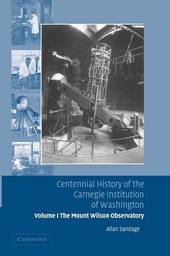
|
Centennial History of the Carnegie Institution of Washington: Volume 1, The Mount Wilson Observatory: Breaking the Code of Cosmi
Paperback / softback
Main Details
| Title |
Centennial History of the Carnegie Institution of Washington: Volume 1, The Mount Wilson Observatory: Breaking the Code of Cosmi
|
| Authors and Contributors |
By (author) Allan Sandage
|
| Physical Properties |
| Format:Paperback / softback | | Pages:662 | | Dimensions(mm): Height 229,Width 152 |
|
| Category/Genre | History of science
Observatories, equipment and methods |
|---|
| ISBN/Barcode |
9781107412392
|
| Classifications | Dewey:507.2073 |
|---|
| Audience | | Postgraduate, Research & Scholarly | | Professional & Vocational | |
|---|
|
Publishing Details |
| Publisher |
Cambridge University Press
|
| Imprint |
Cambridge University Press
|
| Publication Date |
3 January 2013 |
| Publication Country |
United Kingdom
|
Description
Since its foundation in 1904, the Mount Wilson Observatory has been at the centre of the development of astrophysics. Perched atop a mountain wilderness, two mammoth solar tower telescopes and the 60- and 100-inch behemoth night-time reflectors were all the largest in the world. Research has centred around two main themes - the evolution of stars and the development of the universe. This first volume in a series of five histories of the Carnegie Institution describes the people and events, the challenges and successes that the Observatory has witnessed. It includes biographical sketches of forty of the most famous Mount Wilson pioneer astronomers working during the first half of the twentieth century. Contemporary photographs illustrate the development and use of some of the innovative instruments that filled the observatory during this time. This story brings together the elements that formed modern theories of stellar evolution and cosmology.
Reviews'The book is nicely produced and illustrated ... Certainly one for the library, for historians of science, and for nostalgic old astronomers like me! Younger bloods will also learn some good astronomy from it.' David Stickland, The Observatory
|